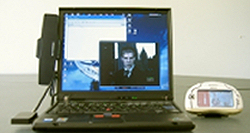The first paper reviewed all aspects of the work of the BMC over the past year. Subsequent presentations discussed multimedia broadcasting to handheld receivers, broadband, the future of TV and media services, an overview of the RRC-04, the technical basis of preparation for the RRC-06, administrative aspects and prequency planning software. The final session covered general spectrum issues including power line transmission interference, and the European Commission's growing involvement in spectrum policy.
Demonstrations
Additionally some informal demonstrations were provided during the coffee breaks to allow the participants to get a little closer to the technology that had been under discussion in the presentations. Multichannel sound from some entertaining interesting files sourced from Swedish Radio were played out in a 5.1 loudspeaker arrangement.
| DVB-H & DVB-T DVB-T and DVB-H reception shown side by side ► |  |
HDTV
To emphasise the consumer availability of HDTV, two versions in HD and SD quality of some film-sourced material was shown side by side on a 50" (127cm) plasma screen and on a 23" (58cm) LCD screen. The native resolution of the screens were 1366 x 768 and 1280 x 768 pixels respectively. The plasma screen showed a 720p version of the film from a data file coded at around 6 Mbit/s using Microsoft Windows Media Player HD, and the LCD a DVD version connected via RGB.
Frequency spectrum issues
The second day of Forecast focussed on Frequency spectrum issues and the demonstrations included examples of frequency planning software from the European Radiocommunications office and the IRT.
